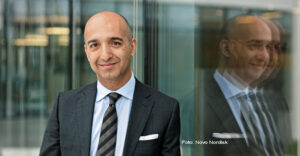Resume af teksten:
Tyskerne oplever en bølge af økonomisk optimisme trods risici og udfordringer. Ifo-indekset, der måler forretningsstemning, steg for syvende måned i træk til 88,6 i juli, hvilket indikerer potentiel vækst i tredje kvartal. Optimismen er drevet af faldende energipriser og forventninger om finanspolitiske incitamenter under den nye regering. Selvom forbrugertilliden er faldet, ser virksomhederne positivt på fremtiden. Regeringens klare kommunikation og undgåelse af fejl har hjulpet på stemningen. Det nylige ‘Made for Germany’-initiativ annoncerede betydelige investeringer, men der er stadig tvivl om deres konkrete effekt. På trods af usikkerhed om økonomisk model og eksterne trusler, viser Ifo-indekset, at penge kan købe optimisme.
Fra ING:
Despite a long list of nearer-term downside risks for the economy, the announced fiscal stimulus is still working its magic – and German businesses are continuing to ride the wave of optimism

The jury is still out as to whether money can buy growth, but today’s Ifo index once again shows that it can at least buy optimism
German business sentiment is still riding the wave of optimism. Even though we still see a large portion of wishful thinking, the seventh consecutive increase in Germany’s most prominent leading indicator remains remarkable. In July, the Ifo index came in at 88.6, slightly up from 88.4 in June, and stands now at its highest level since last summer. While expectations remained unchanged, the current assessment component finally improved, suggesting that growth in the third quarter could pick up again.
Wave of optimism
A wave of optimism seems to have caught the German economy, but it remains unclear whether it is really based on stronger fundamentals or just wishful thinking. It’s probably a combination of both. And to be more precise, the wave of optimism has caught corporate life, not households. While the Ifo index looks almost unstoppable, consumer confidence has fallen for two months in a row and remains weak.
Returning to German businesses, there are several reasons for increasing optimism; after two years of inventory build-up and dropping orders, the inventory cycle started to turn for the better at the start of this year. Energy prices have come down from highly elevated levels, and the prospect of fiscal stimulus has played a role, too. In fact, German businesses seem to be focusing on the bright side of what could happen under the new German government, rather than fearing the downsides from ongoing uncertainty and trade tensions. And at least the optics of the new government are good. German businesses had grown disillusioned with the last government’s ongoing internal controversies. Now, the sheer fact that the new government has avoided big blunders like open controversies or erratic policy announcements and has begun to really implement the announced fiscal stimulus has boosted its popularity.
The latest episode in the government’s confidence-building was this week’s summit between the government and business leaders. An initiative of large German corporates, self-named ‘Made for Germany’, promised to invest €631bn over the next three years. While the headline figure looks impressive, only €100bn of that sum will actually be ‘new’ investments. The rest is previously planned investments. €100bn over three years equals some 0.7% GDP per year. Whether these investments will really reach the economy and how much crowding out of other investments will emerge remains to be seen, as does the question of whether these investments will materially boost innovation or new technologies.
What a difference half a year can make
In any case, just take a step back and remember where the German economy stood at the start of the year: completely in the doldrums with two years of recession, a huge investment gap and an economic business model that was up for a complete overhaul. Seven months later, there is a €500bn infrastructure fiscal stimulus, a ‘whatever it takes’ spending promise for defence, small tax incentives for private investments and a commitment by large corporates to step up investments. What a change!
Admittedly, there are still few signs of an overhaul of the country’s economic model, either in the government’s coalition agreement or in this week’s announcements by the ‘Made for Germany’ initiative. This increases the risk that all investments will lead to higher productivity. However, Germany had the deep fiscal pockets to avoid the policies it prescribed to many other eurozone countries during the euro crisis: structural reforms and austerity. Still, even with the deep pockets, Germany will have to address the weakness of its economic business model quickly. Investments can only be a first step and not the only step.
To be clear, the near-term outlook for the German economy will still be highly affected by the ongoing trade tensions, possible US tariffs and the stronger euro. It remains remarkable that German businesses seem to almost completely ignore these risks. This return of optimism could also get a cold shower next week when the first estimate of second-quarter GDP growth is released. Nevertheless, the longer-term outlook continues to improve. The jury is still out on whether money will be able to buy growth, but today’s Ifo index once again shows that it can at least buy optimism.
Hurtige nyheder er stadig i beta-fasen, og fejl kan derfor forekomme.



